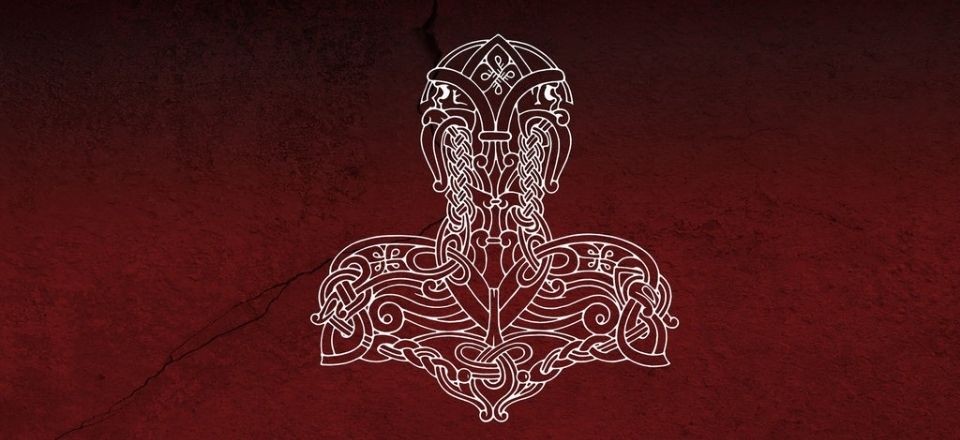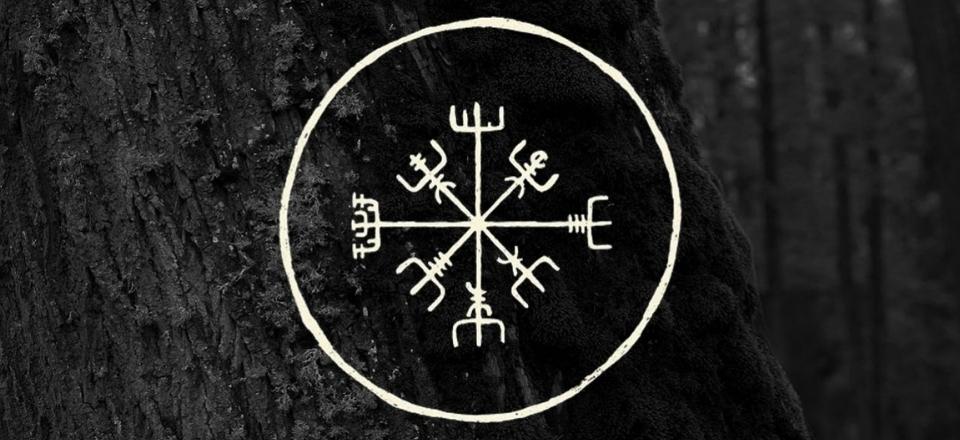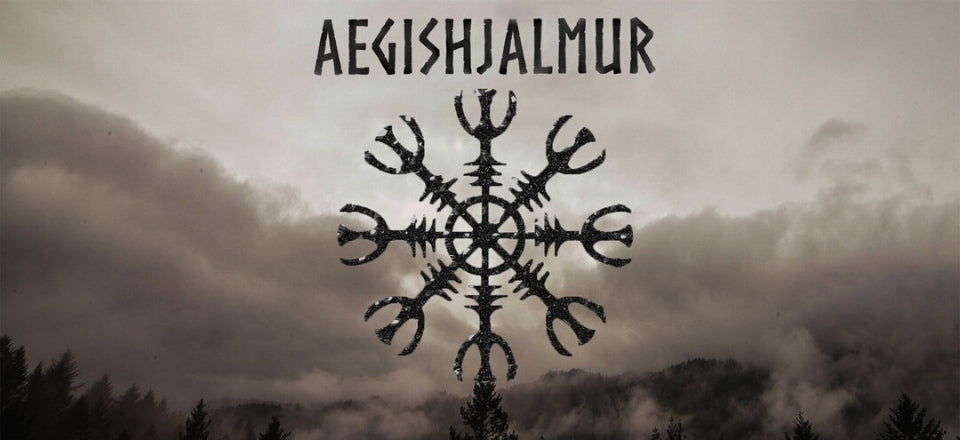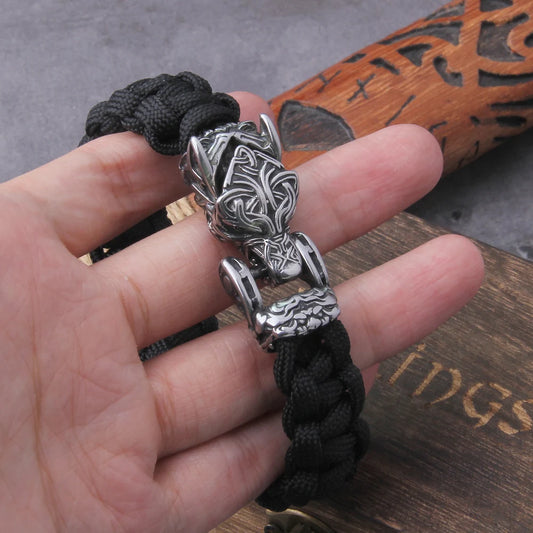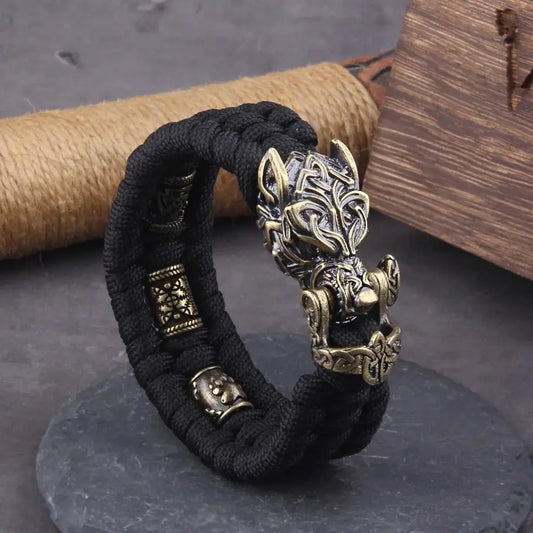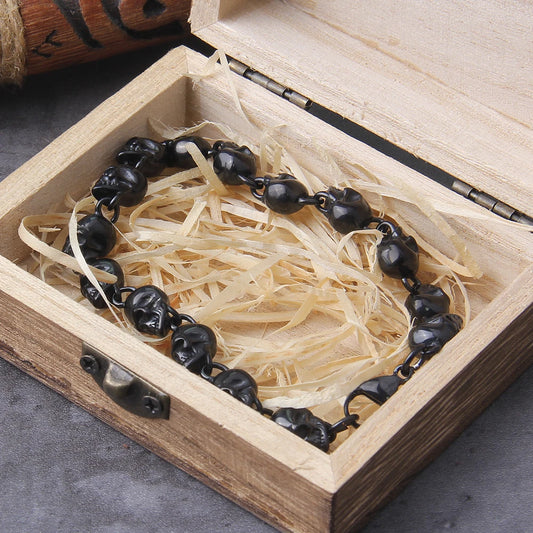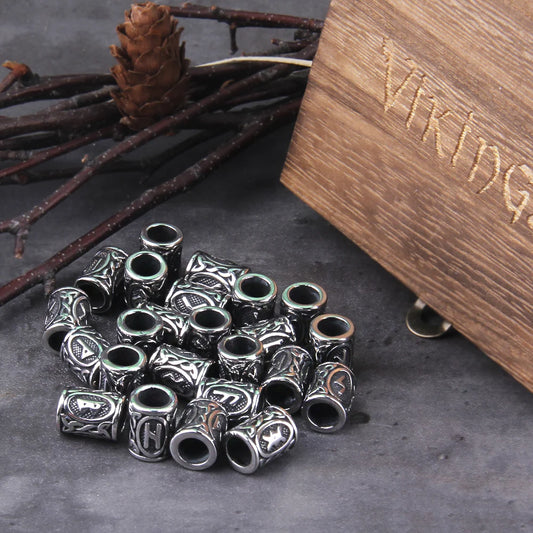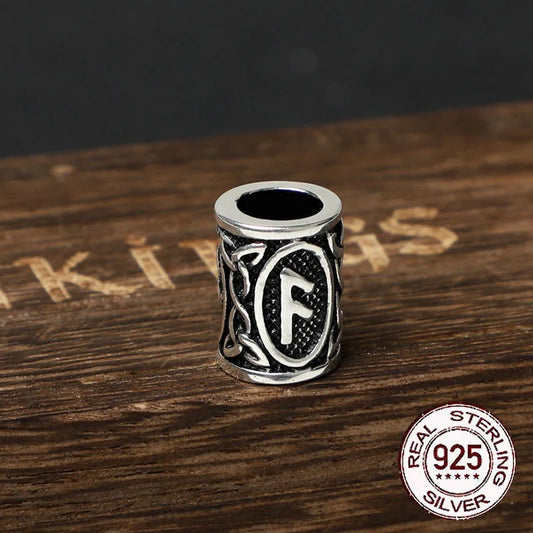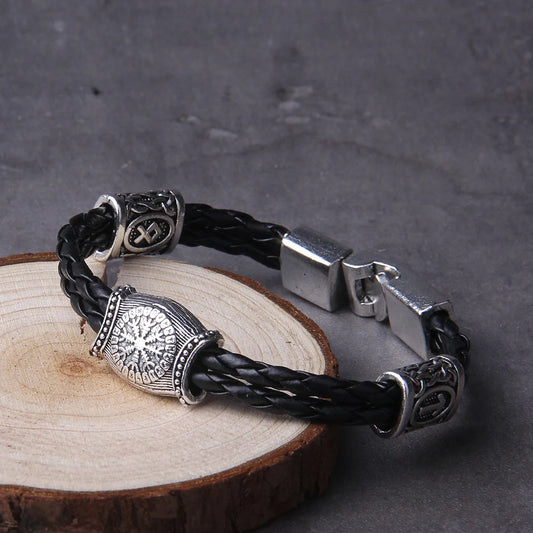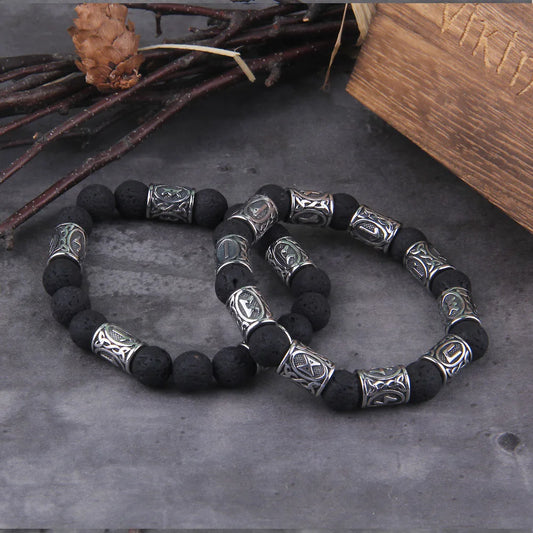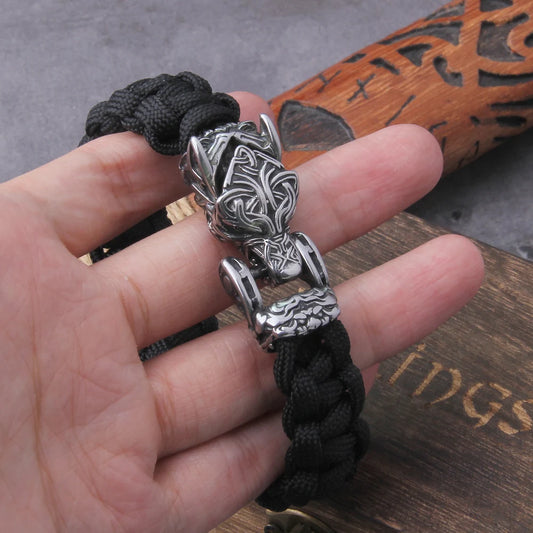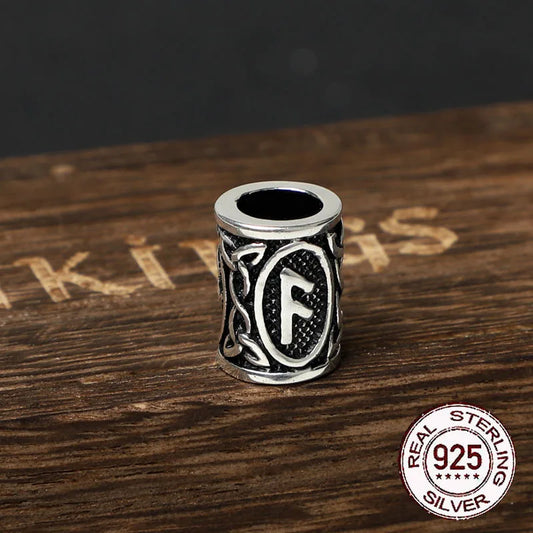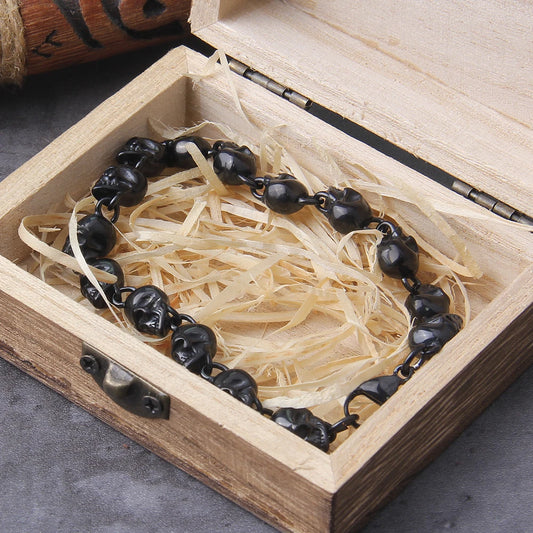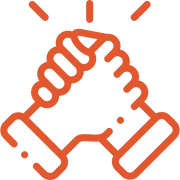The runic alphabet or futhark - a term formed from the name of its first six letters, ᚠ ᚢ ᚦ ᚨ ᚱ ᚲ - is an alphabet that was used for writing proto-Germanic languages by peoples who spoke these languages, such as the Scandinavians, Frisians and Anglo-Saxons.
The runic alphabet, called fuþark after the name of its first six letters, initially had 24 signs. There have been several types of runes, which have evolved over time, but also according to the people who used them.
In the Scandinavian countries, where the runes were most widely used, the number of runes was reduced from the seventh century onwards to a system of 16 runes.
The oldest attested inscriptions are in Denmark and date from the first century (Vimose inscriptions). There may have been earlier ones, but they have not survived because they must have been carved in wood, as many sagas attest.
They are found among the Nordic Germans in the fourth century, but only in the second century among the other Germans, including the Anglo-Saxons who, after their conversion to the Latin alphabet, retained the use of a runic sign, namely Þ, þ (named þorn, thorn).
However, the number of inscriptions relating to these peoples is very limited (more than fifty among the Anglo-Saxons), whereas among the Scandinavians, there are thousands.
The use of this alphabet lasted in Sweden until the nineteenth century in a remote place in Dalarna, whereas in Denmark it was not used beyond the fourteenth century.
The peak of this writing system is thought to have been between the ninth and the eleventh century, at the end of the Viking Age. It is mainly funeral inscriptions, particularly abundant in Sweden.
On the other hand, Iceland, although colonized by the Vikings, did not experience the expansion of runic writing that occurred on the continent: there are about fifty inscriptions at most, and they are late.
The sagas are written in Latin characters and the Þ, þ is borrowed from Old English manuscripts. The most northerly inscription is that of Kingigtorsuak in Greenland; it contains secret runes.
Origin of the runes
The fuþark was created by speakers of a Germanic dialect to transcribe their language. Some scholars claim that the runes were derived entirely from the Greek or Latin alphabet, but most experts consider the futhark to be a mixture of various origins.
In his book Greeks and Goths: A study on the Runes (1879), Isaac Taylor suggested that the runes were derived from an archaic Greek alphabet used by the Greek colonies on the Black Sea and brought to the Baltic regions by the amber trade.
Taylor's theory has been rejected by all runologists, as the archaic Greek alphabet was replaced by the standard Greek alphabet around 400 BC, four centuries before the first runes appeared.
Seebold, Krause, Jensen, Coulmas and Stifter think that the runes originated from a mixture of Alpine-Italian alphabets, especially the Rhaetian and Camunian alphabets of Bolzano-Sanzeno, of which only five runes have no equivalent.
The Alpine alphabets would then have been completed by Latin letters. Some letters have an obvious Latin origin, e.g. the runes for /f/ (ᚠ) and /r/ (ᚱ), others that are reminiscent - at least in format - of the Alpine alphabets: for example, the rune /h/ (ᚺ) with Rhaetian correspondent, the rune /p/ (ᛈ) opposite the Camunian alphabet; and the rune /d/ (ᛞ), obviously taken from the lepontic san (transcribed ś) of the Lugano alphabet. Some letters may be rhaetian as well as Latin, for example the rune /i/ (ᛁ).
Using the contributions of human genetics and relying on a correlation between graphemes observed in situ on Camunian petroglyphs, and on the study of the haplogroup of the descendants of the Camunian Transalpine civilization, Elisa de Vaugüé demonstrates that certain runes could derive from the older Camunian alphabet, dated to 1,000 BC by the archaeologist-anthropologist Giovanni Marro.
This Camunian system, would draw its origins, according to the study of its graphemes, of some of the 32 symbols found in the European caves since 30 000 years, by the Canadian paleo-anthropologist Genevieve Von Petzinger.
Bernal thinks that there were also alphabet substrates; Miller, for his part, claims that the origins of the runic alphabet are the archaic Mediterranean. In the same text, Miller also writes that the phonetic parameters on which the runic alphabet is based are ultimately clearly Semitic, and related to the Byblos and Ugaritic alphabet scenarios as well as the Phoenician alphabet. This theory is not followed at all nowadays.
The difficulty raised by all these hypotheses, however serious they may be, is that none of them is capable of providing a complete explanation of the origin of the fuþark, because of a problem either of dating or of contact between the Germans and the writing systems of their "neighbors.
The oldest runes that have come down to us date from the first century. The earliest inscription is considered to be that found in Vimose, Denmark, and is thought to date from 150 AD: the word Harja engraved on a comb.
A possible first-century inscription (not attested by all scholars) is the Meldorf fibula, which can be read either as in Latin nidi script, or in Latin and runic irih, hiri, or finally in runic iwih, iþih or hiþi.
It is generally accepted that they were not invented before the first century. These primitive runes, up to about 650 A.D, all seem to use the same fuþark of 24 runes (apart from the occasional inversion of 2 pairs of runes).
Most of these inscriptions are very short and difficult to understand. Most of the preserved runes are engraved on stone, but some fragments exist on wood, bark and bone, and some on parchment, the most famous being the Codex Runicus.
It has been suggested - esoterically and without scientific basis - that the ancient fuþark may have much older origins and be related not to the Mediterranean scripts, but to the petroglyphs found in Norway.
Even if one ignores the obvious correlations with other alphabets, and if some signs can evoke similarities with certain runic letters, no serious study supports the affiliation between runes and "Hallristinger writing", which can at best claim the status of proto-writing.
Mythical origin of the Runes
In the Rúnatal (Poetic Edda), a section of the poem Hávamál, the discovery of runes is attributed to Odin. Odin was suspended on the World Tree, Yggdrasil, after being pierced by his own spear, Gungnir, for nine days and nights, in order to acquire the wisdom necessary to exercise power in the nine worlds, as well as the knowledge of hidden things - including the runes.
Original Futhark Runes Alphabet
The original alphabet of the Nordic runes, the 24-letter futhark or elder futhark, was organized in three groups of 8 runes each called ættir (families): the ættir of Fehu, Hagalaz and Tīwaz respectively, the first rune of each group giving its name to the group.
The proto-Germanic names of the runes of the old futhark are:
- Fehu ᚠ,
- Ūruz ᚢ,
- Þurisaz ᚦ,
- Ansuz ᚨ,
- Raidō ᚱ,
- Kenaz ᚲ,
- Gebō ᚷ,
- Wunjō ᚹ,
- Hagalaz ᚺ,
- Nauđhiz ᚾ,
- Isa ᛁ,
- Jēra ᛃ,
- Eihwaz ᛇ,
- Perthro ᛈ,
- Algiz ᛉ,
- Sowilo ᛋ,
- Tīwaz ᛏ,
- Berkana ᛒ,
- Ehwaz ᛖ,
- Mannaz ᛗ,
- Laguz ᛚ,
- Ingwaz ᛝ,
- Dagaz ᛞ,
- Othala ᛟ.
The name of these 24 runes is a linguistic reconstitution because we do not know the name of the runes of the old Fuþark. The only acrophons known to us are those of the runes of the more recent Fuþark (Anglo-Saxon Fuþark, recent Fuþark, etc.)
The reason for the particular order of the runes, completely different from those of the Latin, Etruscan or Greek alphabets, is unknown today. On the other hand, it is known that this order was established quite early and has only undergone minor and occasional variations since then: the first alphabetic sequences found (Kylver stone, beginning of the 5th century) already mention it.
The various hypotheses raised to explain this order, generally based on religious and mystical considerations, are far from unanimous and are not based on any concrete fact.
Use of runes
Runes in divination
Odin "found the runes after he had hung for nine initiatory nights from the cosmic tree of the Nine Worlds, the ash tree Yggdrasil, pierced by his spear in a sacrifice to himself, the greatest of the gods.
Tacitus, in Germania, describes a divinatory practice of the Germans: "Their way of casting lots is always the same. They cut a hazel branch and cut it into strips.
They write a sign on each strip and throw them at random onto a white cloth. Then the official celebrant, if it is a public consultation, or the father of the family if it is a private consultation, addresses a prayer to the Divinities.
Looking up, he draws three lamellae at random and reads the meaning of his drawing according to the signs engraved on these lamellae. If the result prohibits the action about which the drawing was made, it is not mentioned again that day. If the action is authorized, a confirmation by the auspices is required.
The divinatory use of runes is disputed by most runologists. Tacitus does not specify the nature of the signs; moreover, Germania was written around the year 98, i.e. decades before the invention of the runes as an alphabet was attested.
Runes in Alphabet
Runes were usually used for inscriptions in wood, metal, leather and especially stone. They were mainly vertical and oblique marks, and to a lesser extent horizontal or curved marks (some variants do not have them).
This design helped to carve them on hard materials. The ancient runes were not used for long writing works, but rather for short inscriptions. Long inscriptions do exist, such as the Codex Runicus, a Danish law book, but it was written in medieval runes.
Runes in Literature
Runes have been used in literature to create an effect of "authenticity", and to give "historical" indications in the work. Here are five examples: J.R.R. Tolkien, Jules Verne, J.K. Rowling, Erik L'Homme and Rick Riordan.
Runes have been used extensively by J.R.R. Tolkien, notably in The Hobbit (for the map made during the "Adventures of Bilbo"), but also in The Lord of the Rings (Balin's tomb in Moria, and are explained in detail in the appendices of the novel. J.R.R. Tolkien uses runes, but the language is English.
The runes are also very present in Jules Verne. In Journey to the Center of the Earth, whose starting point is Hamburg (Germany), the discovery of an old runic manuscript reveals a secret message that will later lead to the discovery of mysterious passages in Iceland. Verne also uses the runic alphabet, but this time the language used is Latin.
In both Tolkien and Verne, the runic alphabet is identical, but the languages are different.
Hermione Granger, one of the main characters in the Harry Potter series, studies runes from her third year at Hogwarts; it is only stated that it is a difficult subject. In book seven, Dumbledore bequeaths him a rune copy of The Tales of Beedle the Bard containing the "Tale of the Three Brothers" about the deathly hallows (which give their title to this volume of the series); This will help the protagonists to piece together part of the plot, as Hermione, thanks to her four years of elective study of the runes, is able to decipher and translate them, unlike Harry, who, it is stated, "had never learned to read them.
The writer Erik L'Homme uses runes, called "graphemes," in his trilogy The Book of Stars and in A for Association, attributing magical powers to them.
The list of authors who use runes is long, including Christopher Paolini for L'Héritage and the entire production team for the comic books Thorgal and Les Mondes de Thorgal.
Other Types of Runes
Helsingian Runes
Helsingian runes, or unpost runes, owe their name to the Hälsingland region of Sweden, where they were first found, although inscriptions of the same type have subsequently been found in other parts of Sweden. They were used between the 10th and 12th centuries.
Basically they are a simplification of the Swedish-Norwegian runes in which the vertical strokes have been eliminated as much as possible, to which it owes the denomination of "without post", and also part of the horizontal and transverse strokes are replaced by dots.
Of this variant only 15 runes have appeared in the inscriptions, missing the one corresponding to the ã, to have 16 characters like the other versions of the young furthark.
Icelandic Runes
Icelandic runes are another simplification of young futhark, in which some transverse strokes are shortened or replaced by dots. This alphabet was used in Iceland between the 11th and 14th centuries.
In this version there are only 15 runes, because the last rune, yr, disappeared as it became superfluous due to the fact that the sound it represented, /ɻ/, had become a true erre in the Icelandic dialect of Old Norse at the time.
Macromannic Runes
The treatise entitled De Inventione Litterarum attributed to Hrabanus Maurus assigns the origin of these runes to the Marcomans: "Marcomanni, quos nos Nordmannos vocamus", although there is no real relationship with them, and since then they have been known by this name. Wilhelm Grimm dealt with the origin of these runes in 1821.
The Marcoman rune alphabet consists of a curious mixture of Old Futhark and Anglo-Saxon Futhorc runes in an attempt by Carolingian scholars to represent all the letters of the Latin alphabet with runic equivalents. They were used in 8th and 9th century manuscripts mainly from the south of the German-speaking Carolingian empire.
Medieval Runes
Young futhark had spread throughout Scandinavia in the Middle Ages, but its small number of runes lacked written symbols for every Old Norse phoneme.
To alleviate this deficiency, punctuated variants of characters representing voiceless consonants were introduced to represent their voiced equivalents, and vice versa, and several runes were added to cover all vowel sounds.
No single pattern was followed, and Scandinavian runic inscriptions of the Middle Ages show variants of rune types, and often the equivalents of the letters s, c, and z are used interchangeably.
Medieval runes were in use until the 15th century. Most of the preserved Scandinavian runic inscriptions date from the Middle Ages, although there are also some Latin inscriptions, indicating that runes were in common use in the Middle Ages and coexisted with the Latin alphabet for several centuries.
Dalecarlian Runes
The isolation of the Swedish province of Dalecarlia led to the development of a runic type of its own, a mixture of runes and Latin letters. Dalecarlian runes came into use in the early 16th century and were retained in some uses until the 20th century.
There is debate as to whether their use was part of an unbroken tradition or whether people in the 19th and 20th centuries reintroduced them by learning the runes from treatises on the subject. They were used primarily for transcription of the local language, Elfdalian.
Runic Monuments
About 5000 runic inscriptions are found in total, 3000 of them in Sweden.
The most ancient monuments of rune writing were found in Denmark; about 500 rune inscriptions were found there in total.
About 600 rune inscriptions were found in Norway; about 140 in the British Isles; about 60 in Greenland; about 70 in Iceland.
Several inscriptions have been found in Russia, Latvia, Ukraine, Germany and Austria.
Runic inscriptions have also been found in France, Greece, Romania, Turkey and the Netherlands.
A large collection of runic stones is in the collection of Uppsala University. In today's Stockholm, in the Gamlastan area on the corner of Kekbrinken and Pristgotan streets, an ancient stone with well-preserved ligature of runic inscriptions is built into the plinth of an apartment building.
One of the earliest runic inscriptions is considered to be an inscription on a bone crest from Vimose, preserved in a swamp on the Danish island of Funen. The inscription is translated as harja ("name" or "epithet") and dates back to the 2nd half of the 2nd century.
The inscription is thought to have been in use since the 2nd half of the 2nd century AD, but until recently it was believed that the runic script was first used in the 3rd century.
A large number of runic inscriptions are carved on stones; there are also known brakteats, which are round gold plates originally imitating Roman medallions.
Several runic manuscripts are known: "Codex Runicus", "Fasti Danici", "Cotton Domitian", "Codex Salisburgensis, 140".
Very interesting are the runic inscriptions in the Sophia Cathedral in Constantinople, as well as the marble lion from the port of Piraeus in Athens, whose shoulder is covered with runic inscriptions. In 1687 the sculpture was brought to Venice as a trophy.
A runic stone was found in Kensington, Minnesota (USA) in 1898, but the question of its authenticity remains open.
Runic inscriptions were carved or chiseled on metal, wood and stone - the art of wood carving was at a high level among ancient Germans.
The content of runic inscriptions varied greatly: there were various magical inscriptions and appeals to the gods, but for the most part the runes were used to write memorial inscriptions.
A prime example of this is the runic stone from Rhöck, praising the king Tjordik, who lived in the VI century, but the first lines of the inscription on it reads: "Of Vemude speak of these runes. Varin put them together in honor of his fallen son", which may speak of the memorial value of the stone.
Another rune stone from Norway is also an obituary. It reads: "Engl built this stone in memory of his son Thorald who died in Vithaholm, between Ustaholm and Gardar".
Other runic monuments extolled the valor of the Vikings who returned from their journeys. Runic stones, such as the one from Hillersøe in Sweden, tell of the exclusive rights of women among the Germans - the right of women to own property.
Runes carved the names of weapon bearers and artists. But also runic inscriptions of domestic character are known. A large number of runic inscriptions are brakteats; runic calendars are also known.
Runic Calendars
There were also runic calendars, varieties of the "perpetual calendar. In Denmark they were called rimstocks (from rim "calendar" and stok "stick"), in Norway they were called proistaves (from prim "golden number").
They most often looked like sticks or staffs from a few inches to 5 feet long. These calendars were used in Scandinavia and may have their roots in the distant past, but the earliest ones found date from the 14th century.
Of interest to science is Ole Vorma's Computus Runicus, a copy of a manuscript from 1328 in which the runic calendar was fully recorded. On one side were the numbers from April 14 to October 13 (Nottleysa - "nightless days", summer in Scandinavian calendar), on the other side accordingly the numbers from October 14 to April 13 (Skammdegi - "short days", winter in Scandinavian calendar).
To mark the days in the runic calendars, a repeating order of seven runes was originally used. Nineteen "golden numbers" were also noted to find the full moon.
Each of the nineteen numbers was marked with a rune, the numerical value was determined by the alphabetical order, and additional runes were created for the three missing numbers: Arlaug marked 17; Tvimaður marked 18; Belgþor marked 19.
Holidays were marked by special signs. These signs were determined mainly by omens, connected with this or that holiday. For example, June 9 - St. Columba Day - was marked with a picture of a salmon, because, according to the omen, on that day its spawning began.
April 14 - the first day of the calendar summer - was marked with an image of a blossoming bush. November 11 - St. Martin's Day - was denoted by an image of a goose, because St. Martin, when he was elected bishop, was frightened and hid among the geese. In a later era, the days began to be indicated by simple lines, and the nineteen "golden numbers" by Arabic numerals or other numerical signs.

